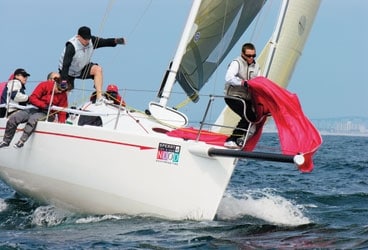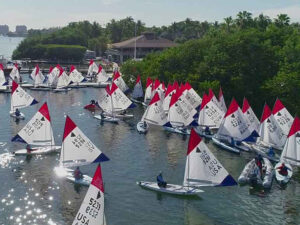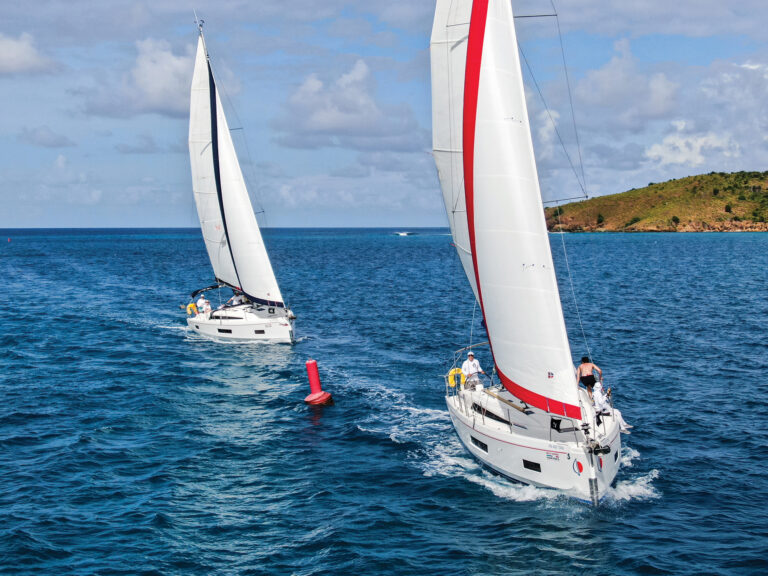
FlyingTiger368
The back-story for the Flying Tiger 10-Meter is a long one, so we’ll boil it down to a few essential facts. Bill Steven, a West Coast-based boatbuilder who has built boats in China, asked designer Bob Perry to design a sportboat that would fit into a 40-foot container and cost $50,000 or less. Perry drew a basic design and sent it off to Steven. Steven then posted the drawing on www.sailinganarchy.com and asked for comments. Commentary came fast and furious, sparking interest in the design. Steven collected $1,000 deposits for the first 50 boats, which were offered at an introductory price of $39,500, before the first boat was even built. What people were buying was a great concept: a dead-simple sportboat with a bare interior, which, thanks to its price, would perhaps someday evolve into a popular one-design class. To make the boat appeal to those who tow their boats, it was designed with a retractable keel, an easily removed, transom-hung rudder, and a swept-spreader carbon rig.We first got our hands on hull No. 6 of the Flying Tiger a the U.S. Sailboat Show in Annapolis, Md., last fall. It was the first boat delivered to the United States, and because everyone, including us, wanted it to be a part of SW’s annual Boat of the Year tests, it was a rush job to get the boat from California to the East Coast in time for the show, and then to rig it for our test sail. Rigging and hardware issues aside, it quickly became obvious the boat wasn’t ready. In mid-March at the Sperry Top-Sider NOOD in San Diego, though, we saw a fleet of eight Tigers on the starting line every day, one of which eventually won the regatta’s overall trophy, and after talking with owners, we could see that many of our issues had been addressed.Building boats at a factory halfway around the world with unskilled (at least initially) labor can be difficult, and there are usually a few missteps. The Flying Tiger 10-Meter is no exception. The first few boats came with under-specced tillers, transoms that were underbuilt, and rudder hardware that wasn’t up to the task of handling the loads of the boat’s outboard-hung rudder. Poorly designed and built class sails didn’t help its debut either. But-and this is important-we saw enough good things to figure out that Steven, Perry, and the denizens of sailinganarchy.com, have delivered exactly what was ordered-an inexpensive sportboat with good performance characteristics. The FT 10-M’s construction is cored fiberglass, except for the single-skin cabin top, and where fiberglass spine frames are located. Unlike many boats, the core in the way of the structural spine was removed, and brought to a single skin laminate, which is thinner than the cored laminate. The structural spine provides localized stiffness where it’s attached, but unless the single skin area has stiffness similar to the cored laminate (through extra layers of fiberglass), a fatigue area can develop in this single skin between the edges of the spine and the cored laminate. The interior has an agricultural, unfinished feel, but will serve well for what most people will do with the Flying Tiger-day race. There are spots where we could see daylight through the laminate, but only in low-stress areas. The settee seats look good until you sit on them, then the 29 inches of headroom will have you leaning inboard. The two bunks under the cockpit are the best berths in the house, especially for overnight races, but again, the FT 10-M isn’t supposed to be any more palatial than any other similarly sized sportboat. There’s plenty of room for storage of essential items, and the deck keeps the rain out. A good aftermarket add-on would be a gasket to keep water from seeping in around the retractable bowsprit.The cockpit is larger, and deeper (17″) than you’ll normally see in 32-foot sportboats, and there’s room for a crew of four or five to work the boat around a racecourse. In San Diego, we saw boats sailing with six or seven crew, which jibes with the class-mandated maximum crew weight of 1,050 pounds. The forward hatch is molded into the forward part of the deckhouse, and wisely, Perry and Steven didn’t even try to make it out of clear polycarbonate, just fiberglass, so it should stand up to abuse well. It’s also plenty large enough for spinnaker takedowns and launches. A tall helmsman will find the lifelines uncomfortable, especially if the boat is heeled over enough to require using the footblocks. Owners who sail in an area where lifelines aren’t required would benefit from taking them off completely, or at least lowering them where the helmsman sits. The nonskid on our test boat was adequate, but not great. We’ve been told that it has since been improved. Immediately aft of the companionway is a well for an outboard engine, with doors that close flush with the hull when the engine is retracted. On our test sail the doors kept opening, but we’ve been told that issue has been resolved.We sailed the Flying Tiger in a fresh 10- to 18-knot breeze last fall. Despite the rush getting the boat together, it held up and sailed well. It tracked well upwind, was easy to get in a groove and stay there, tacked through high angles, and had more of a big-boat feel than some other sportboats we’ve sailed, due in part to its high sides. Off the wind, the game was to put the boat on an angle where it would surf and plane, and keep it there, which was easy to do. In some of the bigger gusts, we recorded boatspeeds of around 16 knots. Granted, there was some current, but sailing at such speeds despite an untuned rig and stretchy halyards is an indication that a well set-up Flying Tiger will be a lot of fun to sail both upwind and down.The San Diego NOOD was a baptism of fire for the eight Flying Tiger owners and their crews, most of whom had little or no time in their boats. We spoke to a few owners and crews and heard many positive comments. When it came time to figure out what class was the most competitive, in order to declare an overall regatta winner, the organizers chose the Flying Tiger class. Class winner Scot Tempesta, the founder of sailinganarchy.com, was declared the overall winner, which seems to bring the story of the Flying Tiger full circle.









